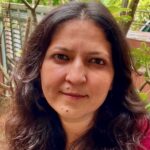“Life is a game of bridge, we did not invent the game or design the cards. We did not frame the rules and we cannot control the dealing. The cards are dealt out to us, whether they be good or bad, we can play the game well or play it badly. A skillful player may have a poor hand and still win the game, and a bad player may have a good hand and yet make a mess of it. Our life is a mix of necessity and freedom, chance and choice. By exercising our choice properly, we can steadily control all the elements and eliminate altogether the determinism of nature.”
This excerpt was read out to me by Dr Rajshekar Krishnan and it’s a beautiful summary highlighting the essence of the conversation I had with him. Dr Krishnan is a mechanical engineer and the Director of Wayda Consultants, but those are just his professional credentials. He’s also a regular practitioner of meditation and an ardent devotee of Sri Ramana Maharshi, and shapes his work, life and spirituality based on Sri Ramana’s teachings. “My journey to spirituality started with my family. I grew up in a typical Brahmin household. While I was growing up, we were based in Delhi though we are originally from South India. My grandfather was a very religious person. My uncle and I would join him every Sunday to practise Surya Namaskars, while we chanted from the Aruna Prashnah of the Taittiriya Aranyaka. I would do 133 surya namaskars as that was the number of prapatakas or chapters in that particular section. My mother inherited my grandfather’s spiritual inclinations and she was always very faithful to the set of four or five ślokas that were given to her by her grandmother. She practised those her entire life. So that’s the background I grew up with. But, I also had my father’s influence which was always rooted in science and rationality as he had a PhD in organic chemistry. So I grew up on a diet of books that ranged from the Gita to the Brahma Sutras to the works of Ramana Maharshi (at my grandfather’s home) and at my father’s home, I would read books on Chemistry. So I grew up with a sound blend of spirituality and rationality and applied both to my work and my spiritual development,” says Dr Kirshnan. “Engineering became a tool that I could then use to discover and decipher spiritual texts that I read. I was a maintenance engineer and maintenance engineering allows you to understand the designs that other people have created so you do a lot of reverse engineering when something breaks down, so you understand how other people thought. That also helped in my own spiritual journey because I tried to understand what the great sages did and in a way reverse engineered (if I can use that phrase) their teachings. After ten years working in the engineering industry, I landed up in training and rose to the rank of a leadership development facilitator — I use my experience in science and spirituality to connect the two.”
This combination of rationality and spirituality has allowed Dr Kirshnan to understand and experience the teachings he spent his childhood reading, and it’s refreshing to hear him talk about spirituality as a subjective science for inner personality development. Self-enquiry is an essential tool for liberation and Dr Krishnan explains this in the context of spiritual self-enquiry. I asked him how he turned his knowledge into experience and he suggested the route of shruti, yukti and anubhava. “This concept is mentioned in the Shankara Bhashya. Shruti: you must first listen to what the wise sages have to say, then apply yukti: your own reasoning and logical deductions and then finally you arrive at anubhava: understanding through experience. It’s similar to sravana, manana and nididhyasana — the three pillars of Vedantic practice.”
Who Am I?
After years of studying the scriptures and trying every form of meditation, Dr Krishnan found that the teachings and meditations of Bhagavan Ramana Maharshi resonated with his own spiritual understanding but it took him years to arrive at this realisation. “My connection with Ramana Maharshi is a fascinating story. My grandfather had a bundle of books from the Ramana Ashram — Five Hymns to Arunachala, Self Realisation: The Life and Teachings of Ramana Maharshi — and initially these books only confused me. I was six or seven years old when I started reading them and while I loved reading them, I couldn’t make any sense of it at that age (laughs). Over the years, I purchased more books by Sri Ramana and kept wondering if I understood what he’s trying to say. I must confess that for many years, I didn’t understand so I kept the books back. A few years ago, I decided to make a serious effort to understand Sri Ramana — I went to Tiruvannamalai — I spent time in the Ashram, and it did me a lot of good, you know. I spent so many years studying the scriptures and trying every form of meditation and I realise now that those were all preparing me and making me ripe to receive the teachings of Sri Ramana. When the shishya is ready, the sadhguru does arrive and that sadhguru is not necessarily a physical form — it can be a bundle of ideas, it can be a spiritual energy — it can be anything that energises you. We need to align ourselves to someone who has had the experience of the spiritual and is grounded in that reality and for me that was Sri Ramana Maharshi,” explains Dr Krishnan.
Throughout our conversation he kept picking books from his vast library and shared them with me. Some date back to 1941 and have been signed by his grandfather, and Dr Krishnan’s love and respect for these tomes of knowledge is evident in the way he has maninted and continues to use these books to enhance his spiritual development. He feels that the desire or icchā for liberation is essential to achieve that said state and explains this through his own journey. “So all the other forms of meditation I practised contributed to my will to meditate — and that is very important. Icchā śákti — that will is needed. I practise self-enquiry or ātma-vichār and it is one of the most deceptively simple and deceptively enigmatic forms of meditation because you don’t know what you’re getting into — it seems so simple yet you don’t know what it is all about. My educational and professional background allowed me to analyse every idea and opinion. Sri Ramana started teaching his method in 1902 when the first shishya, Sivaprakasam Pillai, came to him and asked him, ‘Please lord, explain to me, Who Am I?’ So from that first student in 1902 all the way to 2022, you have 120 years of user-experience (if I can use those words). So many sādhakas have written about how they tackled their quest and the teachings, and if you look at books like, Talks with Ramana Maharshi, Day by Day: with Bhagavan, — you will discover what these sādhakas learned from him and that’s what I did. I ransacked all these books (laughs). I pieced together the entire phenomenon of self-enquiry and was able to practise that to my satisfaction, knowing that I am truly practising not out of a figment of my imagination but as how the sādhakas of Sri Ramana’s tradition taught it. Authors like David Godman and Paul Brunton are among my favourites. The endeavour for knowledge and liberation must always be kept up because that icchā or desire is the one desire we all should and can have as the desire for moksha, for liberation or for vidya is not a transitory desire,” says Dr Krishnan.
Why Should We Meditate?
“We should meditate for the simple reason that all that we read remains only intellectual knowledge unless we experience it. You know, I can pontificate very wisely about the Bhagavad Gita and you may think I am a very wise person. But I am just intellectually articulating it. For the Bhagavad Gita or any spiritual learning or practice to really bring transformative change, you have to have experience. This experience or change comes from meditation. You see, our minds are very hard-wired (if I can use that term) due to our innate neuro biological tendencies or vāsanās. When we meditate, we soften those pathways and allow spiritual energy to change the pathways — because unless there is transformational change in the person practising spiritual practices, all the knowledge remains just on the tip of the tongue — it hasn’t transformed our mind. We need to meditate everyday because it enables that transformation to happen.The mind is very obstinate — pramāthi balavad dṛiḍham is what it is called in the Bhagavad Gita. So in order to transform this obstinate mind, we need the energy of meditation. It’s the difference between apara vidya and para vidya, the former is just empirical knowledge but the latter is a higher knowledge as para vidya through anubhava or the experience of realising is what will create the transformation. So unless you meditate you don’t have the experience or the anubhava of the Self. No transformation or self-realisation is possible without meditation,” asserts Dr Krishnan. We whole-heartedly agree and encourage you, dear readers, to join us on Friday 10th June at 6 PM for a Yoginsights session, where Dr Krishanan will reveal to us the method of self-enquiry. And, if you’re inspired by his words on the Gita, his recommendations for reading the Gita include Bhagavad Gita By S. Radhakrishnan — the author was a former President of India and the person who inspired Teacher’s Day, and for a word-to-word translation, he recommends, Srimad Bhagvad version by Swami Swarupananda published by the Ramakrishna Math.
You can register for Dr Krishnan’s Yoginsights session, here.





